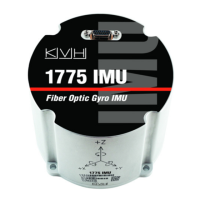This document contains proprietary information of KVH Industries, Inc. and neither this document nor said proprietary information shall be
published, reproduced, copied, disclosed, or used for any purpose without the express written permission of a duly authorized KVH representative.
Page 13 of 77
5 Normal (Default) Mode Messages
5.1 Description
After the unit powers up and completes its initialization routines, it will place itself into Normal
Mode and output a single BIT message, followed by repeated periodic output of motion data
messages. Typically, the unit will output data at the previously configured data rate, although
user-driven data output timing is supported. The output data is in binary format and is not
human readable within typical terminal emulator programs (i.e., it is not ASCII encoded text).
While outputting data in one of the Normal Mode binary formats (for example, Format A,
shown in Table 5-1 and Table 5-2) the unit will listen for ASCII commands, so that a user can
simply type in commands using a terminal emulator program (e.g., RealTerm or equivalent).
The available commands are shown in Table 7-1. Most commands are not recognized in
Normal Mode and there will be no response from the unit unless it is permitted in Normal
Mode. If one of the permissible subset of commands is recognized (e.g., =config,1 or ?bit),
then the unit will respond appropriately.
The unit outputs two basic message types while in Normal Mode. The first type of output
message carries sensor data and status and is output at the configured data rate in one of the
available data formats. (See Section 5.2 for a description of the available data formats.) The
second output message type contains BIT results, which are output at power-up and on user
command. (See Section 5.3 for a description of the BIT data formats.)
Normal Mode output data messages typically include a header code, message packet and a
CRC code. The user should ignore any output from the unit that has an invalid header code or
bad CRC. Binary output follows the big-endian format convention.
The header codes are typically unique bit patterns that can be used to synchronize to the
binary bit stream. This allows operation with a typical computer serial port and RS-422
converter. It is also possible, but not required to use the TOV output as a synchronization
method to the binary data output when using other host systems.
5.2 Normal Mode Data Output Formats
Data Format A (see Table 5-1 and Table 5-2) is the standard or default 1775 IMU message
output. Format B (see Table 5-3 and Table 5-4) is an optional format with timestamp
information. Format C (see Table 5-5 and Table 5-6) is an optional format that is similar to
Format A with magnetic field strengths multiplexed with temperature.
Each format includes a modulo 128 counter that increments with each data output message
and wraps back to 0 after reaching 127. This can be used to verify sequential data reception
and to decode any associated multiplexed item data.
Each format includes a unique header pattern that can be used to identify and synchronize to
the binary bitstream. An alternative for synchronization would be to use the TOV output signal
to indicate the start of an output message.

